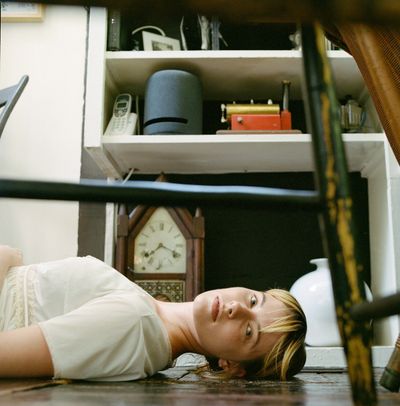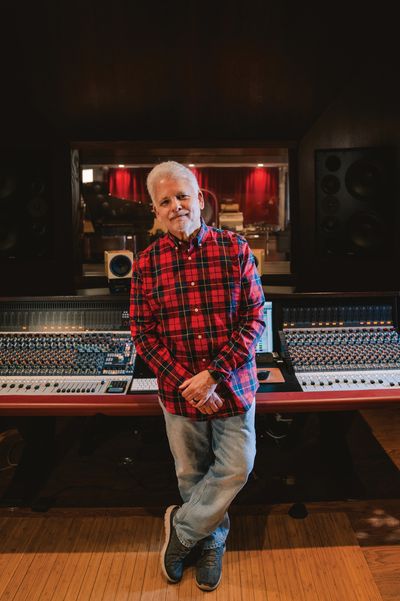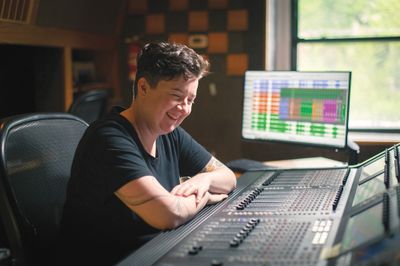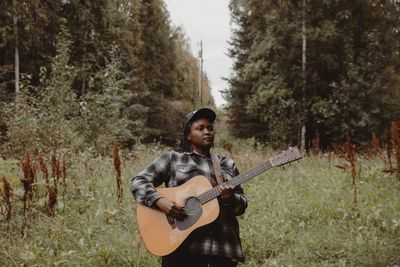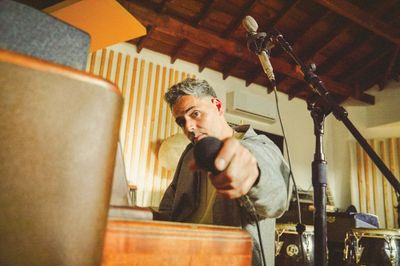Chris Muth of Dangerous Music knows his stuff. Formerly a mastering gear designer at Sterling Sound in New York City, Muth now co-owns Dangerous Music with partner Bob Muller, a unique combination recording studio/boutique gear manufacturer. The Dangerous studio has recorded artists ranging from the Rolling Stones and Rosanne Cash to free-jazz monster Charles Gayle, whereas Dangerous the gear-maker provides a line of über-high-end analog summing, metering, mixing, and monitoring boxes. Tape Op spoke with Muth about his design philosophy, as well as the nuts and bolts of attaining perfection in audio.
What was the impetus behind the Dangerous product line?
I built the first box, what was to become the 2-Bus, for a friend of mine. Once he switched from analog and got a DAW system, he didn't like his mixes as much. He came over to Dangerous and we started trying to get a handle on the situation. When we ran a few tracks at a time, say four or eight faders into a stereo pair in his computer, grouped them, and ran them out into the Neve console, it sounded a lot better than it did going 32 or 48 channels to two inside the computer. He looked at me and said, "Why don't you just build me something that's a simple stereo pairs mixer?" So I built him a prototype, and it turned out that he really liked it. I started to think, "What's the problem? Why does the digital system sound better with analog summing device?" What I found — in a not-so-scientific way, but more or less just using the gear and poking through with my test equipment and ears — is that it's because the faders in the computer could be run a lot hotter, giving you better digital resolution. The summing box, on the other hand, knocked off some gain on its input channels, and it knocked off more gain on a level control at the output section. In other words, specific areas of gain loss in analog were better than the loss necessary for a bunch of channels to go down to two in digital. This was back in the day of 16-bit systems, at a time when the digital stuff just didn't sound good. So that's why we started making the 2-Bus. But the other thing we noticed at the time was that nobody was building a decent monitoring section, or a good cue system with talkback, all the stuff you lost when you got rid of the console.
Describe your R&D process.
It's usually the same for just about any product. We try to figure out the things people need that aren't being made, or that exist but aren't addressing a problem properly. We have a group of about a dozen recording engineers and artists, and other people that we generally deal with on a regular basis. We ask them what they think about particular possible projects, or what they may need. Once we decide a project is worth investigating further, we'll build a couple prototypes, hand them around, and try to achieve a consensus about whether it's something we want to do. If it is, then I'll refine the system, build a dozen working units and run them through the mill. If those work, then we'll release it as a product. On the other hand, if we decide it's too much of a pain in the ass to do, or it's not going to be worth it in time and effort, then we'll pull the plug.
What's the Dangerous design philosophy?
I'll sit down and figure how I'm going to build a box so it's just a monster, it's the shit — it's what I want. And then I say, "Okay, I'll build this monster box; it's gonna cost this much, and it's gonna be this amount of a pain to build," etc. What I don't do is sit down and say, "Okay, I have to build this box for under $200 or we're going to lose our shirt." Which I think is the opposite of how most larger companies work. They'll come up with new products that cost less than $70 a piece to build, then they'll build 10,000 of them and saturate the market, selling the stuff for $300 a piece in some chain store. Whereas we design a box to perform a particular function. And once we build it, then we know how much each unit is going to cost us, how much it's going to cost the store, and finally how much the user is going to have to pay. We ask around and see if it's viable; if the answer is, "No," then we don't do it. Dangerous products are going to be more expensive than a lot of things out there, because unfortunately that's my taste. But I think we have a following of people who anticipate our stuff, and usually we don't disappoint. That's the idea anyway.
When you're designing, do you swap components to find how it changes the response?
Yeah, I do a lot of that during the R&D phase. That process is "voicing the circuit," and that's one of the things that I spend quite of bit a time on very early on. We find what chips we're using, where they are in the circuit, how they function, and how they affect the sound. Voicing the circuit is the first thing that happens, and figuring out how to pay for it all comes last. [laughs]
How important is the power supply?
You basically have to discern between switching and linear supplies. The juice has to come from somewhere, and so the power supply is certainly part of the audio circuit. The audio circuit needs the electricity to run. The other part is the power rails and the distribution system inside the equipment is part of the audio circuitry. Really, the topology and the layout of the circuit boards, the type of wire that's used, the type of solder, how good the connections are, the type of sockets; every single thing that goes into a piece of equipment determines how it sounds. If you stick a pot at the front of the board and run a piece of ribbon cable up to it, that's going to sound different than if you put a stepped attenuator at the back of the board with a long shaft running to it. Every decision that's made involving the layout and component selection of a piece of equipment, including the power supply — right up to the power cord and how the facility is wired — determines how the thing sounds. Having said that, a lot of people are scared of switching power supplies, and with good reason. However, recently they've been getting better as far as noise performance and transient performance, stuff like that. We use linear supplies on our senior equipment is because we can run the voltage rails a little higher. But the switching supplies we use in the 2-Bus LT perform very well, so I'm not worried about them in particular, like some people seem to be.
What else enhances audio quality?
I'm in favor of using good components, stripline transmission technology as far as getting the signals from here to there. Fat ground planes, good quality wire. I use a microscope when I solder because I like to get everything lined up properly, and wires laying in the solder cups properly. Oxygen-free wire for audio; it all makes a difference. The other thing I try to do designing equipment is use a minimalist approach. We look at it and shave down the amount of components to the bare minimum that can get the job done properly. Now, I think some people take this a little too far; they'll say, "I have a passive volume control, so it's better than your active one." I say, most equipment wasn't designed to drive an unbalanced volume pot on 40 feet of cable, and the output isn't designed to go into a power amplifier 30 feet away in the room. Passive to me can be good if you're using two-foot cables, and if the equipment driving the thing and receiving its output are designed for the job. But that's not the reality. So to me that's not the answer; the answer is to use active electronics. Use really good quality active line receivers, good quality potentiometer drivers, potentiometer receivers, summing amps, and line drivers to feed other amps and equipment in other rooms. We build with a minimalist approach, but we include enough components to ensure that all the jobs that have to be accomplished by any piece of equipment are done competently.
How involved are you in the manufacturing of Dangerous equipment?
In the prototype phase, we hand-build every single thing that's in the box. That'll be the first dozen units or so. In the beta testing stage, we hand-build the boards. If we determine it should be an actual product, we'll get loaded circuit boards and attenuators, which relieves some of the burden. At the end of the day though, we still wind up doing the assembly, building the wiring harnesses, connecting it up, testing it. Also, every single box we sell, I test personally. I listen to every unit that goes out the door. That's why I recently moved up to Rosendale [New York]. I've got a house now, with a garage to hold chassis and boxes and boards. I'm turning the living room into a burn-in rack and listening room. We have roughly six people at Dangerous Music involved in making equipment, but I'm the guy that has the test gear. I'm still going to do the final assembly and alignment, listening tests, making sure everything's good. I want every box that goes out the door to be something I want to record with. That's kind of a Muth signature.
Do you enjoy the split between manufacturing and recording? Do you feel that you'd like to do one more than the other?
I enjoy recording. The kind of music I like to record isn't Top 40, chart busting stuff, so it's a little difficult to make a living recording the stuff that I love. But I don't think I'll ever stop, it's the reason why I got in this business in the first place. As for manufacturing, I enjoy designing equipment and listening to stuff and making people happy. Really, all I want to do is make people happy, whether it's recording a jazz band and making it sound fantastic for them, or sitting down and designing some piece of equipment for a mastering guy and having him say that the thing's great and he loves it. That's what I like doing, making other people feel they made right decision by hiring me and my company to solve their problems. But I like strapping on a bass and playing through an Ampeg SVT too, going out in front of people in a nice large club in New York and playing loud rock music. I mean, I love that; it's a lot of fun. So I like doing all sorts of things.
